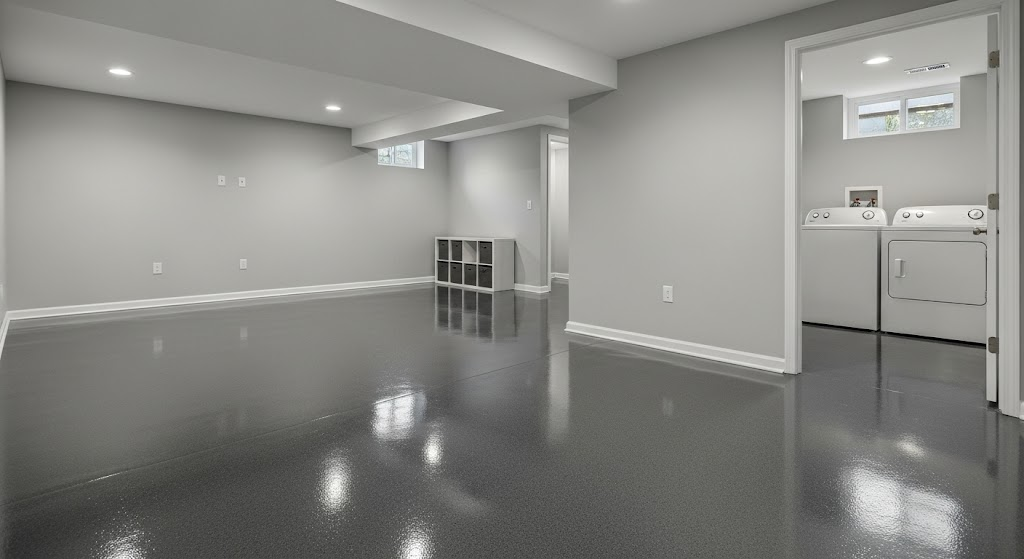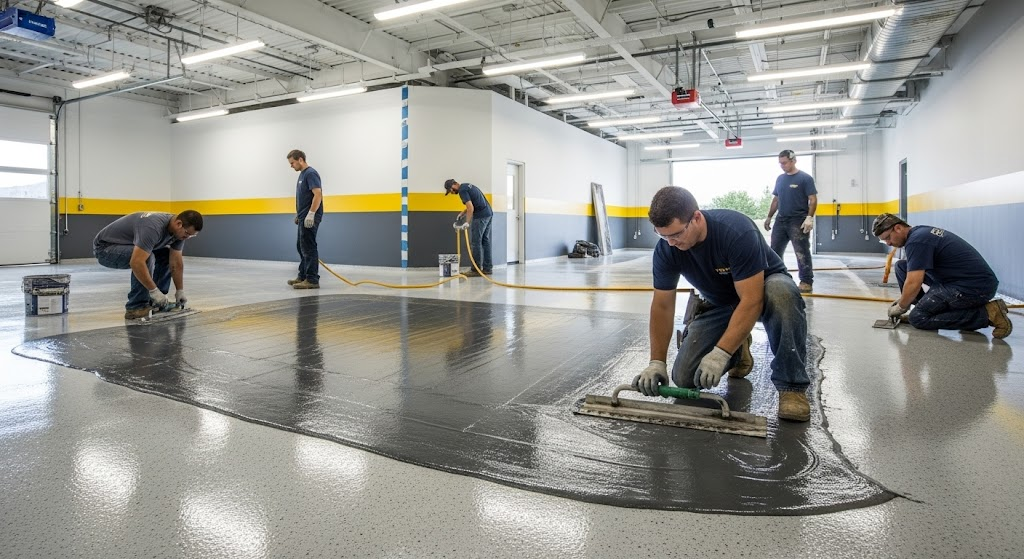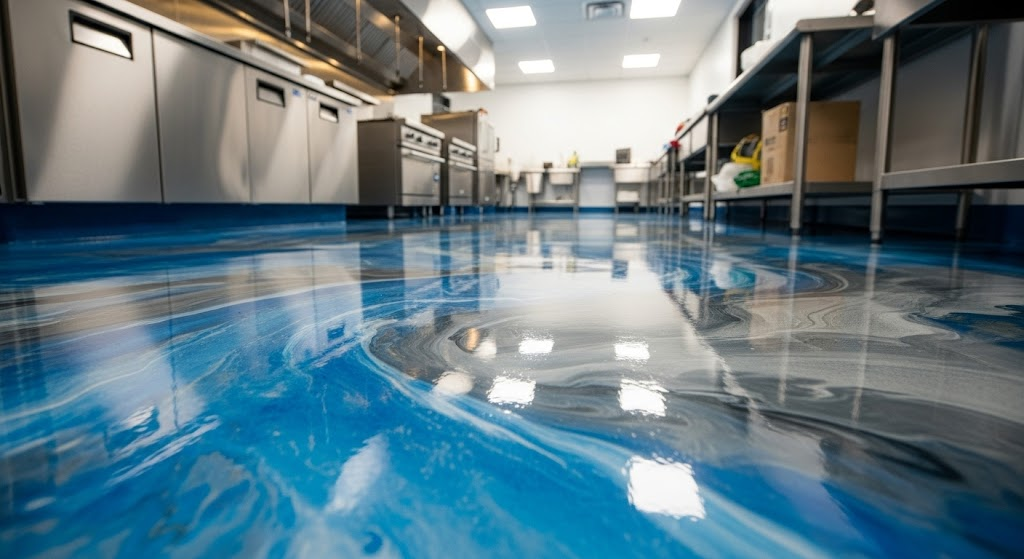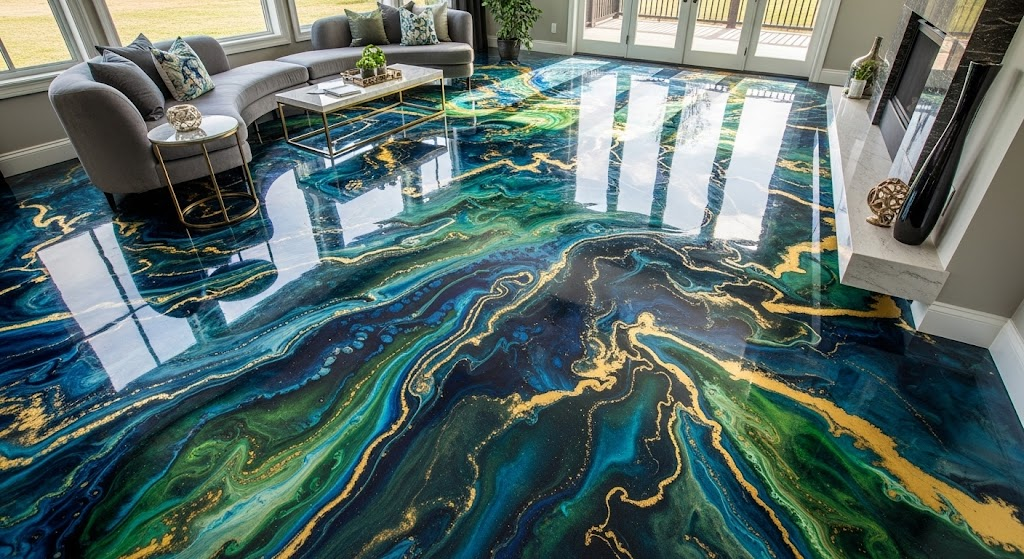One of the most common questions I get is: how long does epoxy flooring actually last? And honestly, it depends on where it’s installed and how much wear it takes.
In this blog, I’ll walk you through the average lifespan of epoxy floors, what shortens or extends it, and what you can do to make yours last longer, whether it’s in your garage, basement, or commercial space.
I’ve worked with epoxy in various settings, and I’ll share what holds up and what doesn’t.
If you’re considering installing epoxy or wondering if yours is due for a refresh, this guide will help you plan and avoid any surprises.
What Is Epoxy Flooring?

Epoxy flooring is a strong, long-lasting surface created by mixing a resin with a hardener to form a durable, plastic-like material.
When applied to concrete, this mixture chemically bonds and cures into a seamless, non-porous finish that withstands pressure, impact, and heavy use well.
It’s commonly used in garages, basements, warehouses, and commercial spaces due to its resistance to chemicals, oil, moisture, and abrasion.
One of the reasons epoxy flooring is so popular is its versatility in appearance.
It can be applied in high-gloss, satin, or matte finishes and enhanced with color pigments, metallic swirls, or decorative flakes for a custom look. Some formulations even include anti-slip additives or UV resistance.
Proper surface preparation and installation are key to epoxy’s performance and lifespan.
When done correctly, epoxy flooring can last for 10-20 years with minimal maintenance, offering an attractive and protective surface ideal for both residential and industrial environments.
Factors That Affect Epoxy Floor Lifespan
Several key factors determine how long your epoxy floor will last, from surface prep and product quality to daily wear and ongoing maintenance.
1. Foot and Vehicle Traffic
Heavy daily use, especially from vehicles, gradually wears down the epoxy surface. Garages, workshops, or commercial areas with frequent movement can show signs of wear sooner.
High-friction spots, such as entrances and tire paths, will deteriorate faster without protective mats or recoating.
In lighter-use residential spaces, epoxy lasts significantly longer due to reduced surface stress.
2. Exposure to Chemicals or Spills
Frequent exposure to automotive fluids, cleaners, or industrial chemicals can weaken the epoxy coating.
Over time, these substances may stain, discolor, or erode the surface, particularly if spills aren’t cleaned promptly.
Using a chemical-resistant topcoat and performing regular maintenance helps minimize damage and prolong the floor’s durability in demanding environments.
3. UV Exposure
Direct sunlight breaks down epoxy over time, causing it to yellow, chalk, or fade, especially in areas near windows or open garage doors.
Most epoxies aren’t naturally UV-stable unless treated with additives or a UV-resistant topcoat.
For outdoor or sunlit spaces, using a protective finish designed to block UV rays is essential for preserving appearance.
4. Surface Prep Quality
Improper concrete preparation is a leading cause of premature epoxy failure. If the surface isn’t cleaned, etched, or ground correctly, the epoxy won’t bond properly and may peel or blister.
Moisture trapped beneath can also cause the coating to rise. Thorough prep, including moisture testing and crack repair, is vital for a long-lasting epoxy floor.
5. Type of Epoxy Used
Not all epoxy products are equal. High-solids professional-grade epoxies form thicker, more durable coatings and typically outlast water-based or DIY kits.
Lower-quality products may cure softer, wear faster, or fail to resist chemicals. Choosing the correct formulation, based on traffic level and intended use, makes a big difference in performance and longevity.
6. Maintenance Habits
Routine cleaning, quick spill clean-up, and reapplication of protective topcoats can significantly extend an epoxy floor’s lifespan. Avoiding abrasive tools and harsh chemicals keeps the surface intact.
Addressing small chips or damage early prevents more serious problems later. Floors that are well-maintained look better and last years longer than those that are neglected.
Pros and Cons of Epoxy Longevity

A quick look at the strengths and weaknesses of epoxy’s long-term performance, from wear resistance to maintenance concerns.
| Pros | Cons |
|---|---|
| Lasts 10–20 years with care | It can peel if poorly installed |
| High resistance to stains | UV exposure may cause yellowing |
| Recoatable in most cases | Not ideal for damp environments |
| Low-maintenance surface | Slippery when wet without additives |
| Suitable for heavy-duty use | Installation requires proper prep |
Signs Your Epoxy Floor Is Wearing Out
Know when your epoxy floor needs attention by spotting early signs of wear, damage, and coating failure before they get worse.
1. Peeling or Flaking
If you notice epoxy lifting at corners or edges, it’s a strong indicator of bond failure. This happens when the coating loses adhesion due to moisture, poor surface prep, or heavy wear.
Once peeling starts, it tends to spread quickly, leaving the concrete exposed and vulnerable to stains, damage, or further coating failure.
2. Faded or Dull Appearance
A loss of shine or color often results from UV exposure, abrasion, or repeated use of harsh cleaners. This fading doesn’t always impact the coating’s performance, but it does signal wear.
When epoxy loses its glossy finish, it’s more likely to absorb dirt and moisture, making it harder to clean and reducing visual appeal.
3. Cracks Beneath the Surface
Structural cracks in the concrete base can compromise the epoxy on top. These cracks may not be visible at first but can eventually cause the coating to split or peel.
If left unaddressed, the damage worsens over time and allows water or chemicals to seep under the surface, accelerating deterioration.
4. Worn Spots in High-Traffic Areas
Areas with constant foot or vehicle traffic, like entryways or garage drive paths, may show signs of thinning or discoloration.
These worn patches can feel smoother and become slippery. This is usually a sign the topcoat has degraded and needs refreshing to maintain protection and prevent damage to the epoxy layer underneath.
5. Yellowing or Discoloration
Sunlight exposure causes most epoxy coatings to turn yellow or fade, especially if no UV-protective topcoat was applied.
Yellowing may not impact durability right away, but it signals degradation of the epoxy’s surface layer. In decorative or light-colored floors, it’s a clear sign that the coating’s protective qualities are fading.
6. Slippery Surface
If your epoxy floor becomes unusually slick, it could mean the texture or anti-slip additives have worn down.
This not only makes the surface unsafe, especially when wet but also points to aging or degraded coatings.
Reapplying a slip-resistant topcoat restores traction and extends the floor’s usability and safety.
7. Blisters, Bubbles, or Pitting
Blisters and bubbles often form from trapped moisture during application or poor surface prep. Pitting may indicate chemical wear or impacts over time.
These issues weaken the coating’s structure and appearance. Once bubbles break or pits deepen, water and dirt can enter, leading to larger-scale failure if not repaired promptly.
8. Stains That Don’t Lift
When spills leave permanent marks even after cleaning, the epoxy’s protective barrier has likely broken down.
This could be due to long-term wear, chemical exposure, or loss of topcoat.
Persistent stains suggest the coating can no longer resist absorption, which means it’s time to recoat or refinish to restore its sealing ability.
Can You Recoat or Refinish Epoxy Flooring?

Yes, most epoxy floors can be recoated or refinished rather than fully replaced, provided the base layer remains in good condition.
Common issues like surface scratches, dullness, or mild discoloration can typically be corrected with a fresh topcoat.
Recoating helps restore the floor’s appearance and protective qualities without removing the original epoxy layer.
For more extensive damage, such as peeling, bubbling, or chipping, the surface may need to be sanded down to ensure proper adhesion.
Thorough cleaning is also essential to remove dust, oils, or residues that could prevent the new layer from bonding effectively.
Recoating is a practical and cost-efficient way to extend the lifespan of an epoxy floor. It refreshes worn surfaces and adds durability without requiring a complete redo.
Proper preparation and using compatible materials are crucial to achieving a smooth, long-lasting result.
How Epoxy Compares to Other Flooring Options
Compare epoxy flooring to other common options like concrete sealers, tiles, and vinyl to see how it ranks in durability, cost, and maintenance.
| Feature | Epoxy | Concrete Sealer | Tiles | Vinyl |
|---|---|---|---|---|
| Lifespan | 10–20 years | 3–5 years | 15–25 years | 10–15 years |
| Maintenance | Low | Low | Moderate | Moderate |
| Slip Resistance | Optional additives | Poor | Moderate | Good |
| Chemical Resistance | Excellent | Fair | Fair | Poor |
| Installation Difficulty | Medium | Easy | High | Easy |
Common Causes of Premature Epoxy Failure
Identify the most frequent reasons epoxy floors fail early, from poor surface prep to environmental factors so that you can avoid costly mistakes.
- Poor surface prep: Skipping grinding or acid etching leads to poor bonding.
- Moisture issues: Water vapor from below can cause bubbling or delamination.
- Improper mixing: Wrong resin-to-hardener ratio weakens the chemical bond.
- Thin application: Applying epoxy too thin can lead to quick wear or chipping.
- UV damage: Sunlight can cause fading and chalking if epoxy isn’t UV-stable.
- Ignoring damage: Failing to patch cracks or chips early leads to widespread failure.
- Using cheap products: Low-quality or DIY kits often lack durability and adhesion strength.
Tips for a Long-Lasting Epoxy Floor
Follow these proven tips to protect your epoxy floor from wear, damage, and fading so it stays strong and looks great for years.
- Test for moisture: Use a moisture test kit before applying epoxy. Moisture coming through the slab can cause bubbles or peeling later.
- Choose the right epoxy type: Use high-solids or 100% solids epoxy for heavy-duty areas. Water-based kits are best for light use and easier DIY jobs.
- Apply in the right conditions: Ideal temperatures are between 60°F and 85°F with low humidity. Extreme temperatures can affect curing and finish quality.
- Use anti-slip additives: Mix non-slip granules into the final coat, especially in spaces prone to water or oil.
- Clean regularly: Sweep dirt and debris often. Mop with mild detergent to keep the surface clean.
- Avoid harsh chemicals: Use epoxy-safe cleaners. Strong acids or solvents can wear down the topcoat.
- Add a topcoat or sealer: A UV-stable or abrasion-resistant topcoat adds an extra layer of protection, especially in high-traffic or sunlit areas.
Conclusion
Epoxy floors are tough, but just like anything, they don’t last forever. With the proper care, you can expect them to hold up for 10 to 20 years, sometimes even longer if they’re not taking daily abuse.
I always tell people: clean regularly, seal as needed, and don’t ignore small chips or cracks. These small habits can make a significant difference in the longevity of your epoxy finish.
If you’re wondering whether epoxy is right for your garage, shop, or basement or if your current floor needs refinishing, I’m here to help.
Leave a comment below with your questions, or message me directly.
I’d love to chat about your project and help you make the best choice. Thank you for reading, and good luck with your floors.

